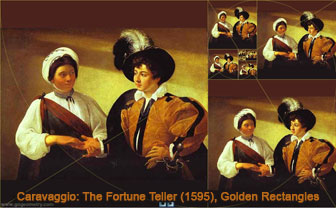Caravaggio
Michelangelo Merisi da Caravaggio (1571 - 1610) was an Italian artist active in Rome, Naples, Malta, and Sicily between 1592 and 1610. His paintings, which combine a realistic observation of the human state, both physical and emotional, with a dramatic use of lighting, had a formative influence on Baroque painting.
The Fortune Teller, Second version (1595)
The Fortune Teller is a painting by Caravaggio. It exists in two versions, both by Caravaggio, the first from 1594 (now in the Musei Capitolini in Rome), the second from 1595 (which is in the Louvre museum, Paris).
The painting shows a foppishly-dressed boy (in the second version the model is believed to be Caravaggio's companion, the Sicilian painter Mario Minniti), having his palm read by a gypsy girl. The boy looks pleased as he gazes into her face, and she returns his gaze. Close inspection of the painting reveals what the young man has failed to notice: the girl is removing his ring as she gently strokes his hand.
Source:
Wikipedia, The Fortune Teller (Caravaggio).
Golden rectangle
A golden rectangle
is a rectangle whose side lengths are in the golden ratio,
one-to-phi, that is, approximately 1:1.618. A distinctive
feature of this shape is that when a square section is
removed, the remainder is another golden rectangle, that is,
with the same proportions as the first. Square removal can
be repeated infinitely, which leads to an approximation of
the golden or Fibonacci spiral.
Droste Effect
The Droste effect is a specific kind of recursive picture, one that in heraldry is termed mise en abyme. An image exhibiting the Droste effect depicts a smaller version of itself in a place where a similar picture would realistically be expected to appear. This smaller version then depicts an even smaller version of itself in the same place, and so on. Only in theory could this go on forever; practically, it continues only as long as the resolution of the picture allows, which is relatively short, since each iteration geometrically reduces the picture's size. It is a visual example of a strange loop, a self-referential system of instancing which is the cornerstone of fractal geometry.
Source:
Wikipedia,
Droste Effect.
